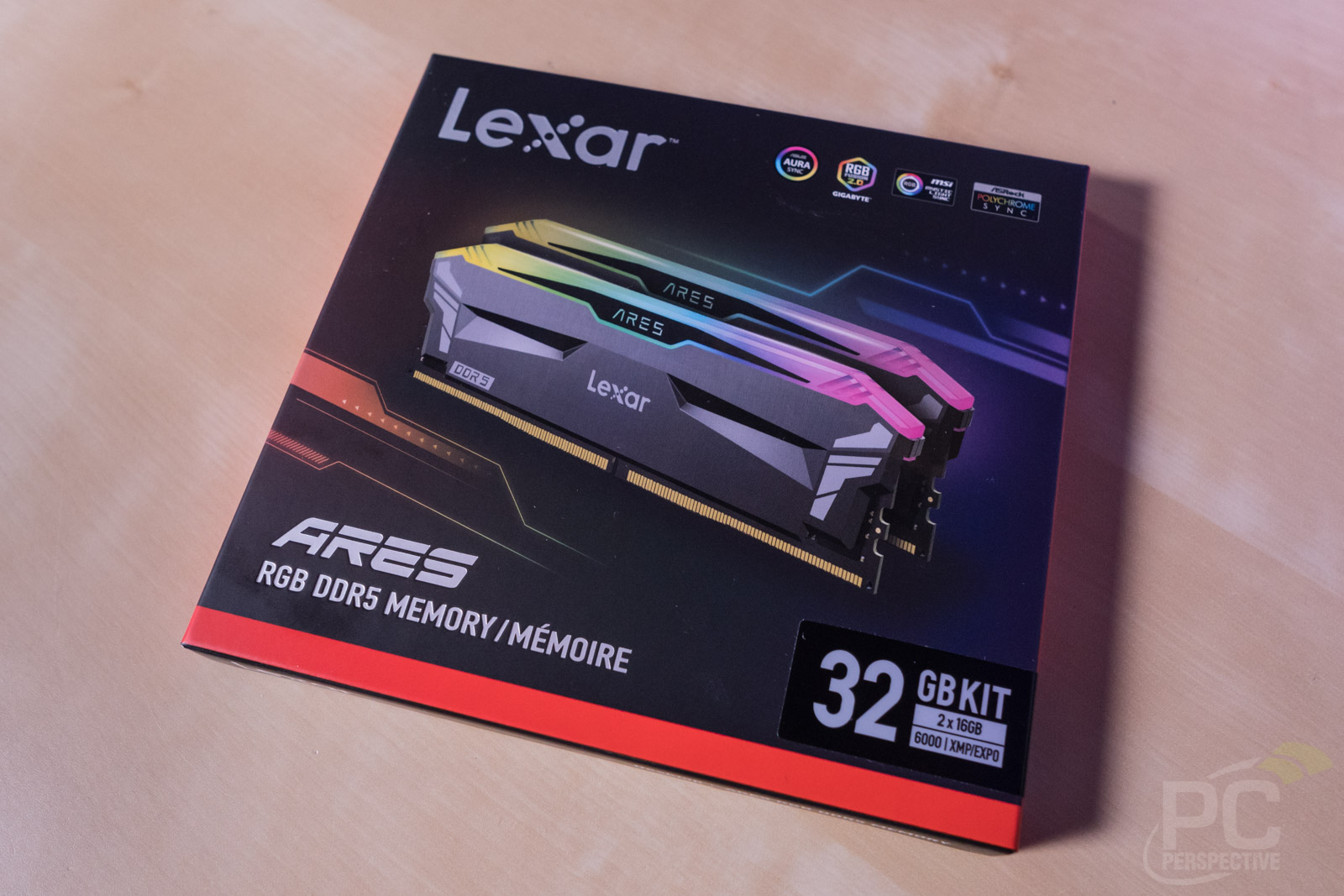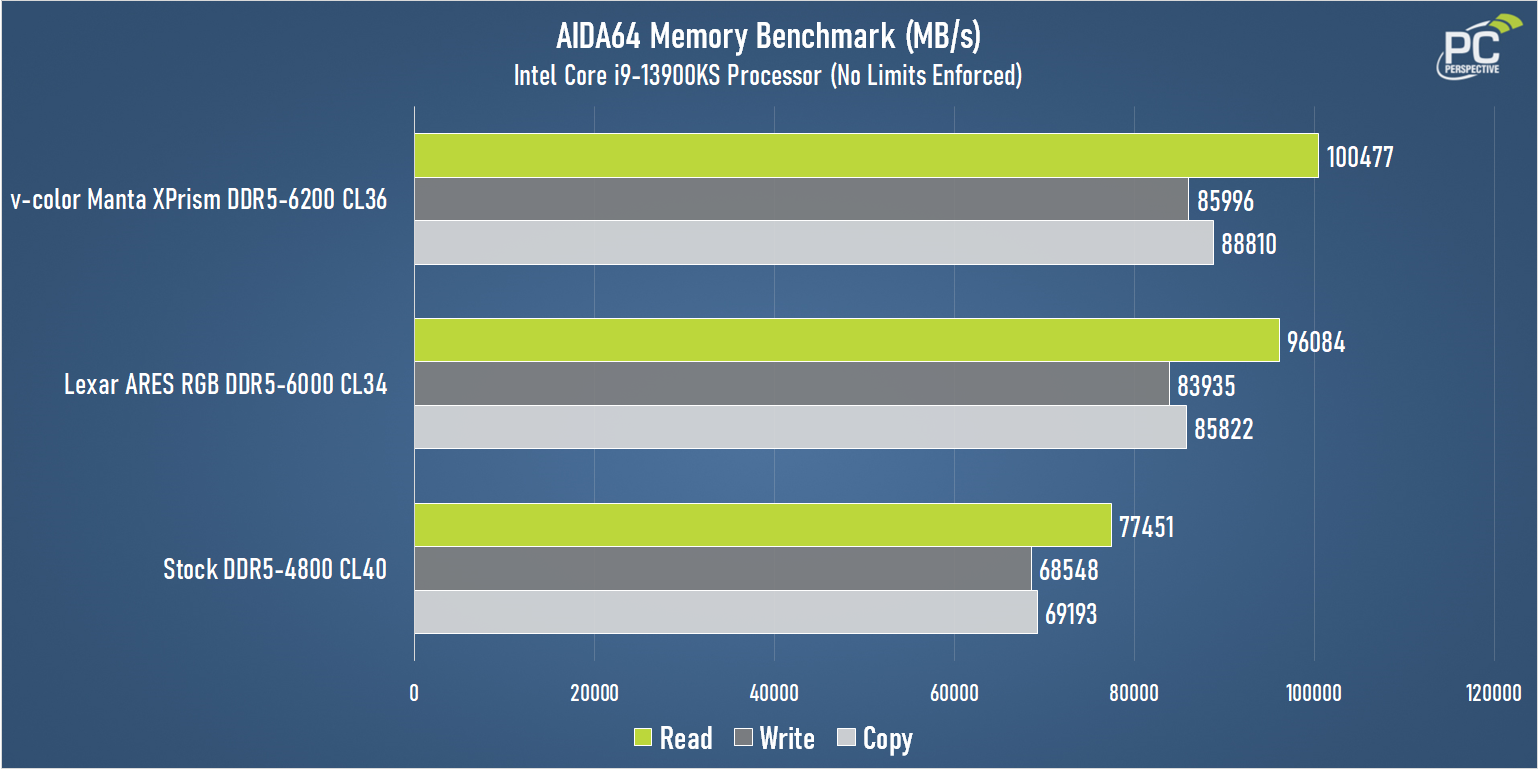Lexar ARES RGB DDR5-6000 Desktop Memory Review

A DDR5 Kit with Hynix M-die Chips
We first looked at a Lexar gaming memory product with the HADES RGB 32GB DDR4-3600 kit, perfect for Ryzen 5000 CPUs, and once again we will be looking at a product that seems tailor-made for AMD systems – but 32GB of DDR5-6000 this time (the sweet spot for Ryzen 7000).
If you don’t happen to remember, Lexar – originally a late-1990’s startup in California – was owned by Micron from 2006 until being sold in 2017 to Longsys (Shenzhen Longsys Electronics Co., Ltd.). Under Longsys the Lexar brand has been offering various professional and consumer storage and memory products since reintroducing the brand in 2018.
Lexar seems to be fond of Greek mythology, with their previous Hades (the Greek god of the underworld) series and this new Ares (the Greek god of war) series. The new Ares (stylized “ARES” in the common all-caps style we know and love so much) modules have slightly more ostentatious styling than Hades, and also feature RGB lighting.
Oh, and upon examination it turns out that the new ARES kit we received contains the coveted Hynix M-die ICs. What this means for overclocking and stability I don’t really know, but I hope it means my AM5 board will love this kit, and not refuse to boot or take five days on memory training. Let’s find out!
Product Specifications
- Capacity: 32GB Kit (16GBx2)
- Memory Type: DDR5
- Interface: 288-pin
- Standard: XMP 3.0 & EXPO
- Speed: 6000Mbps (XMP 3.0 & EXPO)
- CAS Latency: CL34-38-38-76 (XMP 3.0 & EXPO)
- Voltage: 1.2V / 1.4V (XMP 3.0 & EXPO)
- Operating Temperature: 0°C to 85°C (Tcase)
- Storage Temperature: -55°C to 100°C
- Dimension (W x L x H): L140 x W43.3 x H7.9mm (with heat spreader)
Pricing
$149.99 USD list
Manufacturer Description
“The Lexar ARES RGB DDR5 Desktop Memory allows hardcore gamers and PC enthusiasts to experience superior performance with next-gen DDR5. Featuring a premium aluminum heat spreader, game in style and keep your system cool for ultra-fast performance, stability and reliability.”
The Lexar ARES Memory
The ARES kit we received offers 32GB of capacity from its two 16GB DIMMs, and the advertised 6000 MT/s speed is realized via XMP 3.0 or AMD EXPO (well, hopefully – but more on EXPO later).
The timings at 6000 MT/s are 34-38-38-76, and voltage – while incorrectly listed at 1.4V on the packaging – will rise from the nominal 1.2V to 1.3V when setting the OC profile. In light of recent events (CPU/board damage and motherboard vendors clamping down on overvoltage and memory over 1.3 volts discouraged), the 1.3V spec is appreciated.
The mention of “1.4V” on the box is likely a pre-release sample issue, and the DIMMs have the correct voltage printed on the sticker
According to Thaiphoon Burner, the Ares kit contains Hynix 16 Gb M-die ICs, which have a very good reputation based on some internet research and the existence of M-die lists such as this one (though it hasn’t been updated in months).
A Quick Look at Performance
Yes, we will check out a couple of benchmarks – but first, the AM5 saga continues.
After trying for hours to get this kit working at 6000 MT/s on our lone AM5 motherboard – an MSI MEG X670E ACE – I finally gave up and moved the kit to our Z690 testbed. DDR5-6000 is just right for Ryzen 7000 (that glorious 1:1 FCLK / Memory frequency) but alas, our AM5 board is quite finicky. At least, I hope that’s all it is. I haven’t pulled the CPU to check for any damage after running 1.35V memory for months now…
Anyway, I tried Manual OC as well as EXPO, but it didn’t matter. I also tried looser timings, increasing voltage (probably not the best idea), and obscene language, but it still wouldn’t POST on the X670E ACE. I even flashed to a different BIOS (v1.81 from 4/14/23), but no dice. On to the Z690 platform!
On Intel Z690 platform, with the spicy Core i9-13900KS running without any of those pesky power limits, the Lexar ARES memory just works™ at its XMP setting, and we were off and running at 6000 MT/s, CL34, and 1.3V with one click and no POST failures. This is how computing should be. (No, this portion of the review was NOT sponsored by Intel.)
For a quick comparison – since I haven’t tested RAM with the Core i9-13900KS previously – I grabbed the DDR5-6200 kit from v-color that we reviewed a while back, running it at both the XMP and default DDR5-4800 CL40 speed for a reference benchmark. The platform specs were as listed below.
| PC Perspective Test Platform | |
|---|---|
| Motherboard | ROG STRIX Z690-E GAMING WIFI, BIOS 2204 |
| Processor | Intel Core i9-13900KS (No Power Limits Enforced) |
| GPU | NVIDIA GeForce RTX 4080 Founders Edition |
| Power Supply | be quiet! Dark Power Pro 12 1500W |
| Operating System | Windows 11 Pro (Build 22621.525) |
How much of a difference does DDR5-6200 CL36 make over the lower-latency DDR5-6000 CL34 kit on test today? Not much. Here’s a practical example:
Not much of a difference, huh? And 7-zip will actually show meaningful scaling with memory speeds and timings, unlike most applications. Still, if scaling is what you want, there’s no better method than the AIDA64 memory benchmark:
This time the faster 6200 MT/s kit did offer measurably better performance, but we aren’t talking about a ton of improvement here. In short, Lexar’s 6000 MT/s with a CAS latency of 34 is going to be just fine, and if you can run it on your AMD system at that speed you’ll enjoy the glorious 1:1 FCLK / MEM frequency that makes all the difference.
Final Thoughts
Going into this review I was sure it would be as simple as dropping the new DIMMs into our AM5 test platform, running a few benchmarks, and of course taking photos and writing everything up. But that wasn’t the case at all, as memory overclocking – EXPO or otherwise – has become an exercise in frustration with our particular sample motherboard and processor.
I would love to think I’m just doing something wrong, but the news of possible issues with voltages involved in EXPO on AM5 feels just a bit too close to home. I’m genuinely afraid of looking at the pads on my Ryzen 9 7950X and Ryzen 9 7950X3D, both of which I ran with memory voltages of over 1.3V for extended periods of time.
But this is not a review of Ryzen memory overclocking, as it is instead a look at a memory kit from Lexar that just happens to carry the EXPO certification on the package. While I was not able to corobborate compatibility with AMD’s overclocking profile, I was able to drop these DIMMs into an Intel board and have them work flawlessly at the rated speed and latency with a single click.
The sky seems to be the limit with DDR5 frequency on Intel, with even 8000 MT/s kits available from multiple vendors. But for AMD users, I think 6000 MT/s is as high as they ever need to go, because of the whole FCLK / Infinity Fabric thing, and here I hope there ends up being no barrier to entry for prospective buyers as Lexar has set these to 1.3 volts with the EXPO profile – the practical limit for a memory OC on AM5, it seems.
Bottom line, Lexar has a nice offering for those seeking quality DDR5 with their ARES kit, which currently retails for $149.99 on Amazon. It performed very well on our Intel test platform, and the design of these heatspreaders and RGB lighting is pretty darn tasteful. And, while I made a big deal about it earlier, the significance of the presence of Hynix M-die ICs is essentially lost on me – though possibly of great meaning to some.
Review Disclosures
This is what we consider the responsible disclosure of our review policies and procedures.
How Product Was Obtained
The product is on loan from Lexar for the purpose of this review.
What Happens To Product After Review
The product remains the property of Lexar but is on extended loan for future testing and product comparisons.
Company Involvement
Lexar had no control over the content of the review and was not consulted prior to publication.
PC Perspective Compensation
Neither PC Perspective nor any of its staff were paid or compensated in any way by Lexar for this review.
Advertising Disclosure
Lexar has not purchased advertising at PC Perspective during the past twelve months.
Affiliate Links
If this article contains affiliate links to online retailers, PC Perspective may receive compensation for purchases through those links.

















